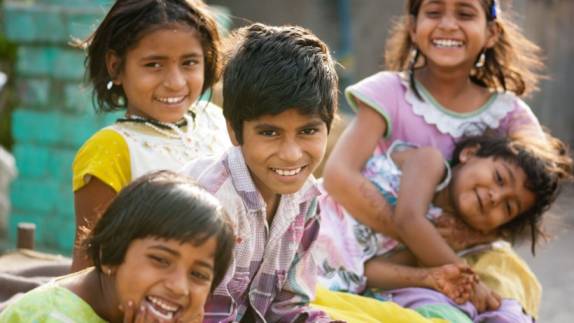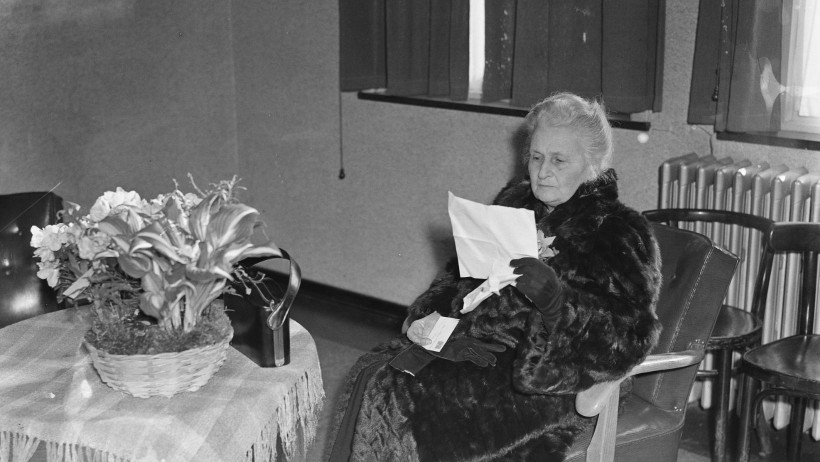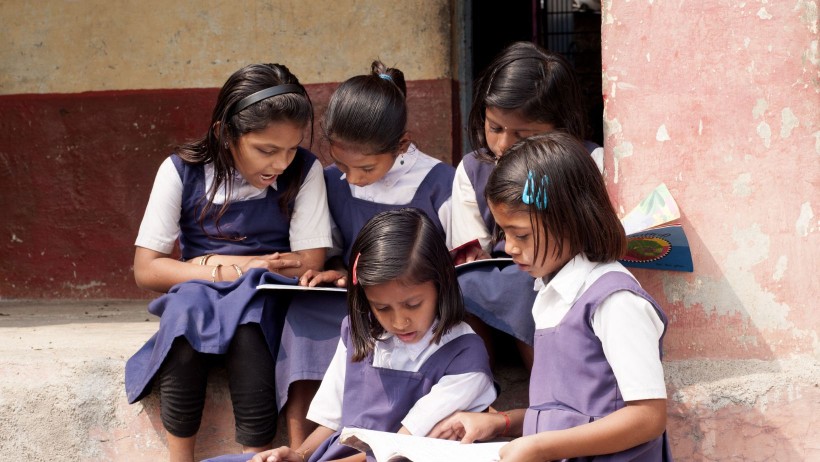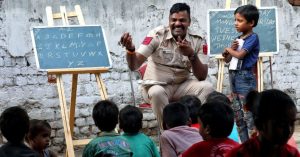Could Inclusive Education for Kids With Disabilities Transform Indian Classrooms?
Jo Chopra and Rupa Bishnoi have worked for decades in inclusivity and mainstreaming of children with disabilities as part of Latika. They explain why inclusivity in early childhood care can go a long way in a person’s holistic development.

This article has been published in partnership with EkStep Foundation.
In the late 1800s, when Dr Maria Montessori was working at a psychiatric clinic in Rome, she would often visit asylums for children with intellectual disabilities (then referred to as “mental disorders”). It was here that she observed that these children needed a more stimulating environment, that “in such a bare, unfurnished room, [they] were desperate for…activities for their hands, and that this deprivation was contributing to their condition”.
This observation was among the first seeds sowed for what is now known as the Montessori method, which, over a century later, has spread far and wide across the world and to children across the spectrum. It encourages a ‘different’, ‘informal’ way of learning. Though acknowledged to have both pros and cons, Dr Montessori’s work has pioneered early childhood education in a way that helps children develop their own pace and learning environments.

Jo Chopra-McGowan, who has worked towards the inclusion of children with disabilities for over 30 years, says that you will often find that inclusive practices don’t just uplift a certain group — they’re for society as a whole.
Jo is the founder of the Latika (previously Latika Roy Foundation, or LRF), an organisation that has, since 1994, worked with thousands of children and adults with intellectual and physical disabilities to help them mainstream in society. Among their key projects is to work with disabled children in their early years, to “catch them young”, as one of their programmes says. This inclusion centres around their education, but also looks to integrate them into the mainstream as a whole and for the long term.
“When Maria Montessori began her work, it was for disabled children. But parents soon realised that this could work for other children too. That’s what we’re always telling people, that when you target the most vulnerable child in the room, your whole classroom will benefit,” she tells The Better India.
‘Everybody is welcome’
Latika’s work with disabled children began when Jo and her husband Ravi adopted Moy Moy, who also lived with a disability.
“We started as just an inclusive play centre where children of all kinds could come after school and engage in fun activities. The only rules were that you play fair and welcome everybody,” Jo tells The Better India. “We saw lots of kids with disabilities coming in naturally; it wasn’t an active effort on our part, but they came because of the inclusive environment we’d built.”
What they learnt later, she says, was that these children with disabilities couldn’t otherwise engage in regular childhood activities like going to the park and that they often had no friends.
“Then it turned out that my own daughter was disabled. We hadn’t looked at it that way until she had to go to school. Then her disabilities really became apparent. For us, she was just Moy Moy, this great, funny, little child. But when she started going to school, it was as if they put a spotlight on her difficulties. That’s when we realised this school system wasn’t right for Moy Moy. Everything at the Foundation has evolved from that.”
India has put in place many provisions in the form of laws and policies for people with disabilities, but the implementation remains questionable. Outlook India noted of all the children with disabilities in India, three-fourths of those aged aged five don’t attend any educational institution. About 12% drop out, and 27% have never attended any educational institute.
Meanwhile, a UNICEF report notes, “The early years (0 to 8 years) are the most extraordinary period of growth and development in a child’s lifetime. The foundations of all learning are laid during these years. Getting the foundations right carries huge future benefits: better learning in school and higher educational attainment, which results in major social and economic gains for society.”

The 2020 National Education Policy has laid great emphasis on inclusion in education that takes into consideration local contexts and diversity. The framework asserts that quality in the early childhood care ecosystem (ECCE) is the highest priority, as is the inclusion and equal participation of children with disabilities and those from economically disadvantaged groups.
So how do we extend the same future benefits to children with disabilities, who are disproportionately affected by an already fractured educational system?
Among the first programmes that the Foundation started was Karuna Vihar, an early childhood intervention centre that encourages the overall development of children between the ages of 0 and 6 by building on their strengths. Parents or guardians work closely with special educators and therapists so they can carry out the activities practised during lessons at home. They are also given counselling services and support group interventions.
Karuna Vihar also focuses on ‘play’ including theatre and creative interventions like exercises to help develop a child’s functional skills. They also involve play in developing individualised education plans for each child to learn speech and language skills and alternative communication systems, as well as encourage sensory stimulation and behaviour management.
Crucial aspects of a person’s life
Rupa Bishnoi, director of diversity and inclusion at Latika, tells The Better India, “When we talk about ‘inclusive education’, we also mean their inclusion in society. We have two catchwords — ‘participation’ and ‘opportunity’. I specifically work for the mainstreaming of our children with the kids, the parents, and the schools. Preparing the schools has become the main focus area for the inclusion team.”
It is commonplace in India for school managements to deny opportunities to children with disabilities — sometimes due to a lack of understanding, and sometimes due to an unwillingness to “take responsibility”. Children may also face bullying and discrimination in these institutions, often with limited intervention by school authorities. Then there is a lack of accessible and safe infrastructure, and special educators.
“We work on a process where we contact schools, hold workshops with them, make them aware of different disabilities, establish relationships…then we try to mainstream our children. For at least a year of support, we provide teachers with strategies, and work preventing the bullying of even parents…This way we’ve managed to mainstream nine children in the last two years.”
Inspired by Canada-based organisation CanChild, Rupa explains that Latika has also developed a Hindi version of a module titled ‘The 6 F-Words’. “These are six functional areas for the inclusion of a child. These include Functioning, Family, Fitness, Friends, Fun, and Future. This covers very crucial aspects of a person’s life.”
Jo notes that inclusion also goes beyond education in the sense that these children need camaraderie.
“For disabled people, opportunities to interact with peers are few,” she says, adding that it is common to loop or keep children with disabilities together, with minimal interactions with a wider circle. “We need to open up these areas so children with disabilities are more visible. That’s where our children’s club Latika Vihar, where these children interact and play, helps. It’s wonderful how they grow up together, the simple and uncomplicated way they interact with each other.”
As a child grows, integration and mainstreaming get tougher. “Children don’t know these boundaries of disparity, class, caste, race….” Rupa notes. “For neurotypical children too, in the early years, it’s natural to have other children in the classroom who are different from them. Teachers are also more accepting of children of this age; there’s more benefit of the doubt. If we send a disabled kid to school without specifying that label or giving them that assessment, we’ve seen that teachers work very hard to make that child adjust. And then the child does beautifully.”
Embracing the ‘difference’
Jo opines that one of the biggest challenges in India’s education system is its rigidity. “There’s an assumption that all children in the classroom learn the same way. We see how that fails so many kids who are already in school. When you bring disabled children into the mix, this becomes more apparent. The blame is put on the children — not just those with disabilities, but also those who have a different way of learning. We label them as ‘naughty’, ‘lazy’, ‘not interested’…The system is designed in a way to exclude at multiple levels.”
“There’s a very academic, literal way of learning, when the fact is that children universally learn better by doing. This idea is not even well understood, let alone implemented. If we cater to this difference in ways of learning, we will automatically move towards more inclusivity.”
Rupa emphasises on a social-emotional learning (SEL) curriculum. This is a process by which a child learns to understand, express, and manage emotions. It is focused on helping them build healthy relationships, manage positive and negative feelings, and develop a sense of empathy and right or wrong. “You need to make each child feel significant, and have a sense of belonging in the classroom.”
She also points towards building responsive classrooms, which are a part of social-emotional learning and emphasises on helping children develop academic, social, and emotional skills in an environment that responds to their needs and strengths.
“Teachers believe a responsive classroom means that children are quick to respond to questions, when it’s actually the other way around. A social-emotional curriculum can build a child’s self-confidence and identity, and develop a sense of empathy with everyone else in the classroom.”
Online studies and material for educators in countries like the US show that responsive classrooms can go a long way in putting a child’s sociocultural makings at the forefront. They remove existing biases, as well as encourage higher academic achievement, improved teacher-student interactions, and higher quality instruction.
The Society for Research in Child Development also opined that these effects are long-term — one study said that even years after, students who participated in SEL programmes fared significantly better than those who did not.
“Benefits were similar regardless of the student’s race, socioeconomic background, or school location. Infrequently assessed but notable outcomes (eg, graduation and safe sexual behaviours) illustrate SEL’s improvement of critical aspects of students’ developmental trajectories,” the study added.
“I also suggest that every ‘regular’ teacher should be given a certification for being a ‘special educator’ after their degree. We need to do away with the idea of having specific special educators to tackle the shortage of these instructors,” Rupa adds. “Everyone who wants to be a teacher has to be a special educator too.”
‘These creative strategies help children as a whole’
Circling back to how inclusive education is actually beneficial for all children, Jo says, “Young teachers will come to us with a ‘problem child’ and say, ‘This kid just won’t sit still, they’re constantly disruptive…’. Then we give them a strategy to tackle the issue.”
“Almost invariably, the teachers come back to us to say that these strategies haven’t just solved their original problem, but have also benefited other students in the class somehow. Learning to take turns, to wait, to know that this class you hate will be over and one you love is coming up next…these creative strategies help children as a whole.”
Sonali Saini, an inclusive pedagogy and education consultant with 25 years of experience in the field, also notes that in any classroom, or even within a family, any two children may be different and have diverse ways of learning. “Diversity exists across the classroom. For instance, there might be a child who is a migrant, who is not from the same city…in that case, they may be equally non-verbal as, say, a child with autism. So why do we continue to not address that diversity and see it as invisible?”
Meanwhile, Rupa says that the results of such interventions are very visible in the parents too. “Their mothers have more confidence, they chat with the other moms, they start dressing better, they feel like they’ve started being accepted in society now. It has an effect on the entire family.”
She recalls the example of Aarti, a young girl with cerebral palsy who was mainstreamed into a prestigious school in Vasant Vihar, Delhi, last year. “She’s learned to carry herself well, and she looks forward to other children greeting her every day — ‘Hello Aarti! Bye Aarti!’. Academically she may not be able to do what they do, but she looks forward to the swing time, meal time…And all the other children run to help her.”

“In the process, her mother, who used to say things like ‘Main nahi padhi toh marr toh nahi gayi. Aarti nahi padegi toh kya marr jaayegi? (I didn’t die because I didn’t study. Will Aarti die if she doesn’t?)’ is now determined to see her daughter’s education through. That’s the kind of change inclusive education can bring.”
To learn more about early childhood care, click here.
Edited by Pranita Bhat
Sources:
‘Unmet Targets, Unfulfilled Expectations: India’s Progress With Disability Rights’: Written & Published by Outlook India on 8 May 2023
‘Early childhood education’: A Report by UNICEF
‘How Children With Special Needs Are Being Left Out of Mainstream Education in India’: Written by Anisha Reddy for The Wire; Published on 15 July 2022
Taylor, R. D., Oberle, E., Durlak, J. A., & Weissberg, R. P. (2017, July). Promoting Positive Youth Development Through School-Based Social and Emotional Learning Interventions: A Meta-Analysis of Follow-Up Effects. Child Development, 88(4), 1156–1171. https://doi.org/10.1111/cdev.12864
Principles & Practices of Responsible Classrooms
If you found our stories insightful, informative, or even just enjoyable, we invite you to consider making a voluntary payment to support the work we do at The Better India. Your contribution helps us continue producing quality content that educates, inspires, and drives positive change.
Choose one of the payment options below for your contribution-
By paying for the stories you value, you directly contribute to sustaining our efforts focused on making a difference in the world. Together, let’s ensure that impactful stories continue to be told and shared, enriching lives and communities alike.
Thank you for your support. Here are some frequently asked questions you might find helpful to know why you are contributing?


This story made me
-
97
-
121
-
89
-
167













